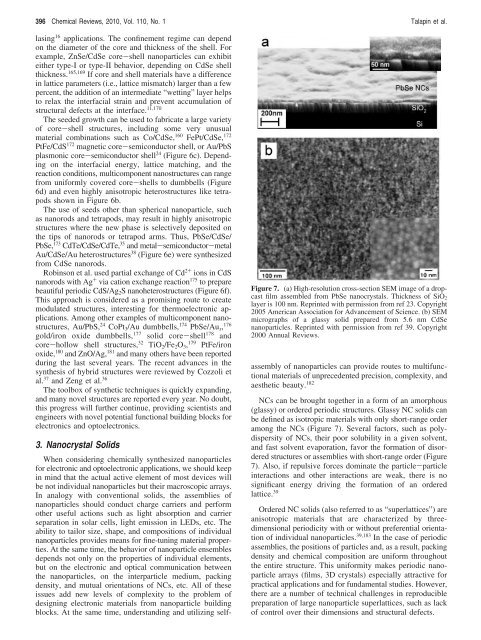Prospects of Colloidal Nanocrystals for Electronic - Computer Science
Prospects of Colloidal Nanocrystals for Electronic - Computer Science
Prospects of Colloidal Nanocrystals for Electronic - Computer Science
You also want an ePaper? Increase the reach of your titles
YUMPU automatically turns print PDFs into web optimized ePapers that Google loves.
396 Chemical Reviews, 2010, Vol. 110, No. 1 Talapin et al.<br />
lasing 16 applications. The confinement regime can depend<br />
on the diameter <strong>of</strong> the core and thickness <strong>of</strong> the shell. For<br />
example, ZnSe/CdSe core-shell nanoparticles can exhibit<br />
either type-I or type-II behavior, depending on CdSe shell<br />
thickness. 165,169 If core and shell materials have a difference<br />
in lattice parameters (i.e., lattice mismatch) larger than a few<br />
percent, the addition <strong>of</strong> an intermediate “wetting” layer helps<br />
to relax the interfacial strain and prevent accumulation <strong>of</strong><br />
structural defects at the interface. 11,170<br />
The seeded growth can be used to fabricate a large variety<br />
<strong>of</strong> core-shell structures, including some very unusual<br />
material combinations such as Co/CdSe, 160 FePt/CdSe, 172<br />
PtFe/CdS 172 magnetic core-semiconductor shell, or Au/PbS<br />
plasmonic core-semiconductor shell 24 (Figure 6c). Depending<br />
on the interfacial energy, lattice matching, and the<br />
reaction conditions, multicomponent nanostructures can range<br />
from uni<strong>for</strong>mly covered core-shells to dumbbells (Figure<br />
6d) and even highly anisotropic heterostructures like tetrapods<br />
shown in Figure 6b.<br />
The use <strong>of</strong> seeds other than spherical nanoparticle, such<br />
as nanorods and tetrapods, may result in highly anisotropic<br />
structures where the new phase is selectively deposited on<br />
the tips <strong>of</strong> nanorods or tetrapod arms. Thus, PbSe/CdSe/<br />
PbSe, 173 CdTe/CdSe/CdTe, 35 and metal-semiconductor-metal<br />
Au/CdSe/Au heterostructures 38 (Figure 6e) were synthesized<br />
from CdSe nanorods.<br />
Robinson et al. used partial exchange <strong>of</strong> Cd 2+ ions in CdS<br />
nanorods with Ag + via cation exchange reaction 175 to prepare<br />
beautiful periodic CdS/Ag2S nanoheterostructures (Figure 6f).<br />
This approach is considered as a promising route to create<br />
modulated structures, interesting <strong>for</strong> thermoelectronic applications.<br />
Among other examples <strong>of</strong> multicomponent nanostructures,<br />
Au/PbS, 24 CoPt3/Au dumbbells, 174 PbSe/Aux, 176<br />
gold/iron oxide dumbbells, 177 solid core-shell 178 and<br />
core-hollow shell structures, 32 TiO2/Fe2O3, 179 PtFe/iron<br />
oxide, 180 and ZnO/Ag, 181 and many others have been reported<br />
during the last several years. The recent advances in the<br />
synthesis <strong>of</strong> hybrid structures were reviewed by Cozzoli et<br />
al. 37 and Zeng et al. 36<br />
The toolbox <strong>of</strong> synthetic techniques is quickly expanding,<br />
and many novel structures are reported every year. No doubt,<br />
this progress will further continue, providing scientists and<br />
engineers with novel potential functional building blocks <strong>for</strong><br />
electronics and optoelectronics.<br />
3. Nanocrystal Solids<br />
When considering chemically synthesized nanoparticles<br />
<strong>for</strong> electronic and optoelectronic applications, we should keep<br />
in mind that the actual active element <strong>of</strong> most devices will<br />
be not individual nanoparticles but their macroscopic arrays.<br />
In analogy with conventional solids, the assemblies <strong>of</strong><br />
nanoparticles should conduct charge carriers and per<strong>for</strong>m<br />
other useful actions such as light absorption and carrier<br />
separation in solar cells, light emission in LEDs, etc. The<br />
ability to tailor size, shape, and compositions <strong>of</strong> individual<br />
nanoparticles provides means <strong>for</strong> fine-tuning material properties.<br />
At the same time, the behavior <strong>of</strong> nanoparticle ensembles<br />
depends not only on the properties <strong>of</strong> individual elements,<br />
but on the electronic and optical communication between<br />
the nanoparticles, on the interparticle medium, packing<br />
density, and mutual orientations <strong>of</strong> NCs, etc. All <strong>of</strong> these<br />
issues add new levels <strong>of</strong> complexity to the problem <strong>of</strong><br />
designing electronic materials from nanoparticle building<br />
blocks. At the same time, understanding and utilizing self-<br />
Figure 7. (a) High-resolution cross-section SEM image <strong>of</strong> a dropcast<br />
film assembled from PbSe nanocrystals. Thickness <strong>of</strong> SiO2<br />
layer is 100 nm. Reprinted with permission from ref 23. Copyright<br />
2005 American Association <strong>for</strong> Advancement <strong>of</strong> <strong>Science</strong>. (b) SEM<br />
micrographs <strong>of</strong> a glassy solid prepared from 5.6 nm CdSe<br />
nanoparticles. Reprinted with permission from ref 39. Copyright<br />
2000 Annual Reviews.<br />
assembly <strong>of</strong> nanoparticles can provide routes to multifunctional<br />
materials <strong>of</strong> unprecedented precision, complexity, and<br />
aesthetic beauty. 182<br />
NCs can be brought together in a <strong>for</strong>m <strong>of</strong> an amorphous<br />
(glassy) or ordered periodic structures. Glassy NC solids can<br />
be defined as isotropic materials with only short-range order<br />
among the NCs (Figure 7). Several factors, such as polydispersity<br />
<strong>of</strong> NCs, their poor solubility in a given solvent,<br />
and fast solvent evaporation, favor the <strong>for</strong>mation <strong>of</strong> disordered<br />
structures or assemblies with short-range order (Figure<br />
7). Also, if repulsive <strong>for</strong>ces dominate the particle-particle<br />
interactions and other interactions are weak, there is no<br />
significant energy driving the <strong>for</strong>mation <strong>of</strong> an ordered<br />
lattice. 39<br />
Ordered NC solids (also referred to as “superlattices”) are<br />
anisotropic materials that are characterized by threedimensional<br />
periodicity with or without preferential orientation<br />
<strong>of</strong> individual nanoparticles. 39,183 In the case <strong>of</strong> periodic<br />
assemblies, the positions <strong>of</strong> particles and, as a result, packing<br />
density and chemical composition are uni<strong>for</strong>m throughout<br />
the entire structure. This uni<strong>for</strong>mity makes periodic nanoparticle<br />
arrays (films, 3D crystals) especially attractive <strong>for</strong><br />
practical applications and <strong>for</strong> fundamental studies. However,<br />
there are a number <strong>of</strong> technical challenges in reproducible<br />
preparation <strong>of</strong> large nanoparticle superlattices, such as lack<br />
<strong>of</strong> control over their dimensions and structural defects.
















